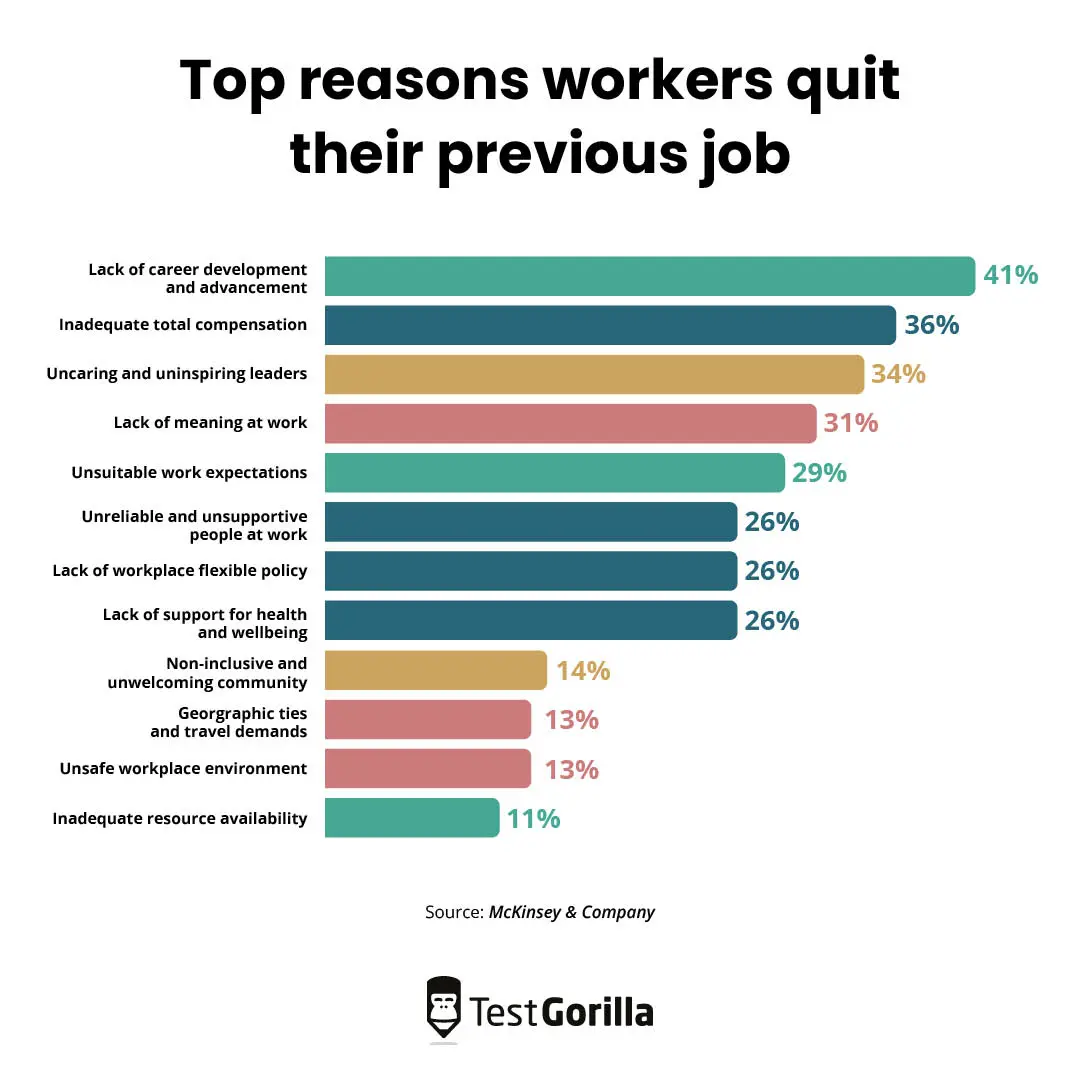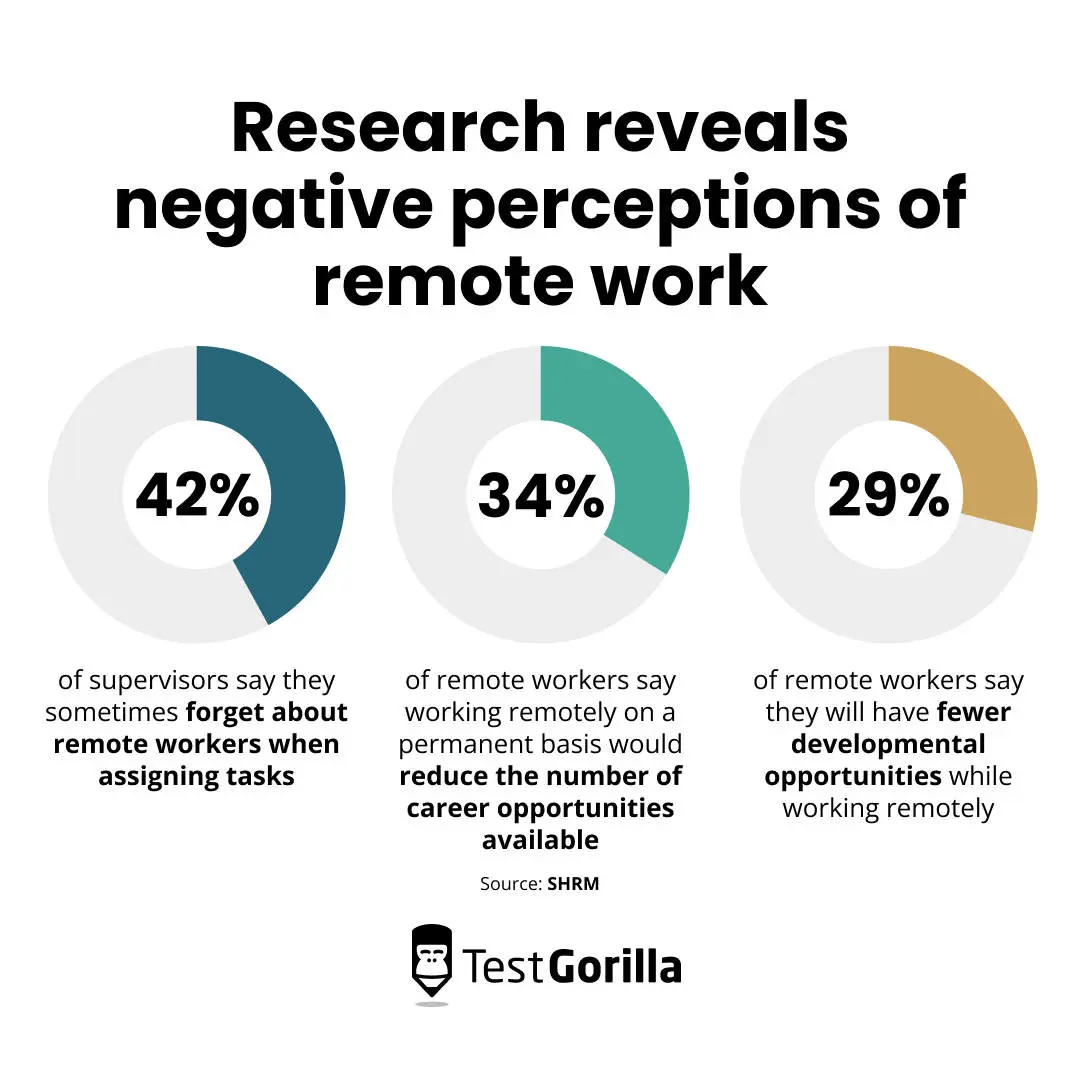Employee turnover refers to the rate at which workers leave a company within a set period.
Some staff turnover is inevitable for any business – even the best workplaces see a number of employees leave for other opportunities or due to career pivots and major lifestyle changes.
However, if you find that employees are leaving your company at an unusual rate, there’s likely an issue within your organization.
This can be costly: Acquiring a new employee to replace someone can cost anything from one-half to two times the role’s annual salary, and that’s just a conservative estimate![1]
Talent assessments are one of the strongest tools in your arsenal when it comes to reducing employee turnover.
In this blog, we cover how talent assessments help reduce employee turnover, including strategies to reduce staff turnover with skills testing.
But first: What causes employee turnover?
Table of contents
- The causes of employee turnover
- The difficulties with reducing employee turnover
- How talent assessments help reduce staff turnover
- 7 strategies to reduce employee turnover with talent assessments
- Beyond talent assessments: 3 best practices to remember for reducing employee turnover
- Reduce employee turnover by using talent assessments to match candidates to the right opportunities
The causes of employee turnover
We mainly focus on voluntary turnover in this blog – in other words, employees quitting – but many of the tips below help prevent involuntary turnover, too.
Voluntary turnover is high in the US, with 4.5 million people quitting their jobs in March 2022 alone.[2] There are many reasons for this.
McKinsey research shows that the number one cause of voluntary turnover between 2021 and 2022 was a lack of career development and advancement, closely followed by inadequate total compensation.
To motivate workers to stay in their jobs, therefore, employers need to demonstrate clear career paths through the company hierarchy and provide opportunities for development.
They also need to compensate their workers, either financially or with non-traditional employee benefits.
The research also found that leadership plays a growing role in reducing employee turnover. In previous years, a high salary compensated for a bad boss, but this is no longer true.
When deciding how to lower employee turnover, then, employers should start by demonstrating fair and compassionate leadership.
Other top reasons for high employee turnover include:
Lack of meaningful work
Unsustainable work expectations
Unreliable and unsupportive people at work
Lack of workplace flexibility
The difficulties with reducing employee turnover
We’ve covered the common causes of employee turnover, but identifying which ones affect your employees specifically is one of the main challenges.
To do this, you need to understand your employees’:
Skills
Responsibilities and workload
Team dynamic
Values and motivation
Traditional hiring methods offer little help when trying to measure these factors, and many organizations also neglect to listen to employees’ feedback about these topics.
Nearly half of regular employees and 40% of executives don’t believe their feedback is used to create meaningful change.[3]
Even in cases where you can identify the issue causing people to leave, the solution for how to reduce turnover may not always be within reach. A common example is competitive salary expectations.
Particularly in a candidate’s market, where there are more open roles than skilled candidates to fill them, it may be difficult to offer a salary that matches or exceeds your competitors.
This problem is even more pronounced when hiring during a skills shortage because workers are able to command especially high salaries.
This makes it harder to hold onto existing employees and to find candidates who are a good match for your organization in the first place.
The result is that you might find yourself compromising on skills or culture to fill a vacancy, increasing the likelihood of quick quitting or needing to let the employee go – both costly and counterproductive outcomes.
Furthermore, if key employees leave, this destabilizes your team and makes it harder to create a psychologically safe atmosphere. Their remaining colleagues are likely to follow suit.
How talent assessments help reduce staff turnover
Talent assessments are best known for increasing hiring efficiency, but skills-based hiring has also been shown to increase employee retention in 89% of companies.
Here’s why.
They’re fairer and more inclusive
Traditional hiring methods like resume screening and unstructured interviews don’t provide a basis for data-driven decision-making, leading to bias in hiring.
Take interviews. Yale researchers found that even when interviewers had been trained in objective hiring, both male and female scientists preferred to hire men.[4]
Talent assessments, on the other hand, directly test candidates’ relevant skills and create an objective shortlist. This radically improves diversity in your hiring.
A study of more than 2,000 successful job applications showed that the number of women hired into senior roles jumped by nearly 70% when skills-based hiring methods were used.[5]
Don’t underestimate the benefits this can bring for reducing employee turnover.
Higher levels of gender diversity and the presence of HR policies focused on this issue have both been linked to lower employee turnover.
They ensure candidates have the skills necessary for their role
Talent assessments also help you hire more accurately than traditional tools like resumes because they test the skills candidates will use every day.
Not only can candidates be confident in their abilities, but they are unlikely to be thrown into a role where they have little ability to perform. This reduces the likelihood of stress and burnout.
Deloitte researchers found that skills-based companies were almost twice as likely to retain top performers and more than twice as likely to innovate than their traditional competitors.[6]
They help you hire candidates who share your company’s values
Talent assessments can also be used to evaluate candidates’ values and how they would contribute to your workplace culture. For instance, you can use skills tests to check candidates’ alignment with your overall corporate purpose.
Our Motivation test helps you check that the candidate would find fulfillment in your open role. The lack of this, as we’ve already seen, is a key motivator for quitting.
They assist with strategic workforce planning
The objective data from skills tests can be used after hiring for strategic workforce planning.
Use your detailed knowledge of the skills in your workforce to craft innovative initiatives, put together teams for upcoming projects, and plan future hiring sprees, both internally and externally.
This can put you ahead of the competition: Just one-third of human resource leaders say their companies use data effectively in workforce planning.
This improves overall wellbeing and company culture
The cumulative effect of using skills tests to reduce employee turnover is an uplift in overall employee wellbeing and company culture.
Fair hiring practices mean candidates feel valued for their skills, not their superficial qualities, and recognize their organization’s commitment to diversity and inclusion.
This impacts employee morale, job satisfaction, mental health, and overall happiness. One study found that workers who believed their employers were doing the right amount or even “going too far” on DEI issues scored 12 points higher on a workplace happiness index than those who said their employers weren’t doing enough.
Finally, skills tests alleviate workplace conflict because teams are assembled on the basis of shared motivations and values instead of superficial characteristics that could cause cliques to form.
7 strategies to reduce employee turnover with talent assessments
Now that you know the broad benefits of using skills assessments to reduce employee turnover, it’s time to get specific.
Here are seven strategies to reduce employee turnover that you can implement in your organization today.
7 strategies for how to reduce employee turnover: Summary table
In the middle of a retention crisis and need answers fast? Here’s a summary:
7 strategies for how to lower employee turnover | Summary |
1. Conduct a skills gap analysis | Define your business goals and the aptitudes needed in each team, test your employees with talent assessments, identify gaps, and create a plan to address them |
2. Hire for culture add, not culture fit | Use our Culture Add test to ascertain how candidates align with your overall mission |
3. Find workers who are skilled at working remotely | Test candidates’ personality types, communication styles, and responses to custom questions to assess remote work capabilities |
4, Design personalized development plans for new employees | Use new employees’ pre-interview assessment results to create development plans that fill out their existing skill sets and give them paths to promotion |
5. Create a stellar onboarding process | Check skills test results for areas that might hinder candidates’ abilities to assimilate into their teams and prioritize these in training |
6. Track employees’ progress through their training | Re-test employees’ skills using the same skills tests as they move through training programs and compare the results |
7. Build an internal talent marketplace | Create a searchable database that shows employee skills so you can “shop” in-house candidates for new roles |
1. Conduct a skills gap analysis
The first step to making your hiring more effective is to conduct a skills gap analysis.
87% of companies worldwide either already have one, or expect to within a few years.[7]
Unnoticed skills gaps contribute to burnout and high turnover rates because employees are forced to try to fill in or compensate for the gaps without support from management.
Here’s how to reduce employee turnover by identifying skills gaps:
Define your business goals
Involve your leadership in setting your medium- and long-term goals
Measure skills internally using talent assessments
Identify gaps in the key skills you’ve identified
Create a plan to address skills gaps
Repeat the process regularly
Here’s how that might look for a high-turnover sales team:
Task | Summary |
Define business goals | - Department and team leaders identify broad goals, such as increasing market share - They note the actions this will require, like automating lead generation - They identify the key skills required, for instance, using customer relationship management (CRM) systems |
Measure skills internally | - Skills tests are used to measure the sales team’s skills with CRM systems, plus other skills like communication and time management |
Identify skills gaps | - Low scores are underlined – for example, the team might show a lack of familiarity with CRM software |
Create a plan | - The sales team attend a training seminar on sales automation software |
Repeat the process | - The same test is applied a month after the seminar, showing improvement |
With necessary skills up to par and their processes streamlined, the salespeople can keep up with their goals to increase market share and are less likely to quit.
HR professionals can also engage in proactive recruitment by evaluating their skills needs alongside the organization’s goals, planning in advance for hiring instead of waiting for a gap to open up.
2. Hire for culture add, not culture fit
The traditional concept of “culture fit” relies on superficial methods like the “beer test” – an interviewer asking themselves if they would get a beer with the candidate – to create a healthy culture.
However, this method is rife with unconscious bias, with hiring managers unintentionally favoring similar personality types and rejecting those who deviate from the status quo.
Culture add, on the other hand, is when candidates share the organization’s underlying values while bringing skills to the table that aren’t already represented.
Our Culture Add test identifies these candidates and can help ensure that everyone in your organization feels included and connected to your mission.
Studies show that workers who feel included are almost three times more likely to feel committed to their organizations. They are also more likely to pursue development and promotion.[8]
3. Find workers who are skilled at working remotely
Work-life balance is a higher priority in today’s workforce than ever before, with remote work options enabling more people to pursue flexible career paths.
This is especially important to millennial workers. More than 90% of people born between 1980 and 2000 say flexibility is a top priority in choosing a new role.
Remote work also makes working more accessible for parents and those with caregiving responsibilities, disabled professionals, and many more.
However, remote work culture can become toxic without the right management, leading to high turnover and low employee satisfaction if poorly managed.
In fact, 42% of supervisors say they sometimes leave remote workers behind when assigning tasks, and more than a third of remote employees report that remote work limits their career opportunities.
Skills tests help you reduce staff turnover in your remote or hybrid company by ensuring you’re hiring remote employees who can thrive in a digital work environment and managers who can handle remote teams.
In addition to gauging candidates’ familiarity with key software, skills tests can illuminate:
Their personality types
Their communication styles
Their answers to custom questions
For example, you might ask a management candidate to write a response email to a remote employee asking to alter their working hours to see how they would respond.
4. Design personalized development plans for new employees
As we saw above, career growth and development are front-of-mind for most employees. Some studies cite a lack of learning and development opportunities as the number one reason people leave their jobs.[9]
One of the ways to reduce employee turnover is by using the insight you’ve gained from skills tests during the hiring process to build professional development plans for your new employees.
These should target development areas and add new skills that align with their overall career plans.
For instance, if a social media manager scored well on social media strategy and expresses an ambition to manage a team, their plan might:
Strengthen their existing strategy skills
Introduce leadership and management into their skill set
Build adjacent skills, for example, introducing them to new software
This contributes to reducing employee turnover because:
It demonstrates your investment in employees
It gives employees clear paths to promotion
It incorporates skill growth throughout the employee life cycle
It’s no wonder that 93% of chief executive officers who introduce upskilling programs like these see improvements in talent acquisition and retention.
5. Create a stellar onboarding process
First impressions count in hiring: New hires are twice as likely to plan to leave an employer if they have a bad employee experience during onboarding.[10]
Talent assessments can help you hone your new employee onboarding processes to reduce staff turnover.
Firstly, examine new recruits’ test results and note any skill areas that might inhibit them in their first days on the job. This might be familiarity with a software platform or their email communication style. Prioritize these issues in their introductory training.
Next, look at the results from their personality and motivation testing. Use this to inform how you design their training and introduce them to their team.
An extroverted candidate might benefit from in-person training with a team member or manager and a mixer event with their team to make introductions.
An introverted candidate, on the other hand, might prefer to receive written instructions to follow independently and meet their new colleagues one-on-one.
6. Track employees’ progress through their training
You don’t need to stop using skills tests once a candidate is hired. In fact, they become even more useful when you reuse them over time.
As in the skills gap analysis example above, you can use talent assessments to track an individual or a team’s progress through employee training and development programs, re-administering the same test at intervals and comparing employees’ scores.
For instance, you could re-test an employee’s leadership and management skills as they progress through a leadership development plan.
Using talent assessments like this not only shows you how an employee’s skills are developing but also indicates:
Employee engagement in their training
How effective different training programs are
How well your overall learning and development initiatives work – this is useful when justifying this spending to leadership
This helps reduce employee turnover by giving you a detailed overview of employees’ development. If their progress stalls, you can check in with them to give them more support or re-jig their plan instead of discovering there’s a problem when they hand in their notice.
It also facilitates internal mobility by giving you regular updates on employees’ skills and fresh data points to support a case for promotion or transfer to a new team.
7. Build an internal talent marketplace
In the last of our strategies to reduce employee turnover, you need to find a way to hold all of this information and manage your talent pool. To do this, input all employee skills test data into an internal talent marketplace.
This is a software platform or simple spreadsheet that collates employees’ skills data for easy perusal.
Internal talent marketplaces enable better internal recruitment by giving you a searchable database of the skills you have in-house, empowering you to put together cross-functional teams and identify candidates for promotion or reassignment to adjacent teams.
If you do invest in internal talent marketplace software, employees may even be able to shop for internal opportunities themselves and apply to new roles and projects through the system.
This creates clear, accessible, and fair paths to promotion and internal mobility for employees, which is essential when considering ways to reduce employee turnover.
Studies show that employees who move within your organization are three times more likely to be engaged than those who don’t, and this is one of the key ways to reduce employee turnover.[11]
Beyond talent assessments: 3 best practices to remember for reducing employee turnover
Talent assessments are an invaluable tool to reduce staff turnover, but they’re not a silver bullet.
Higher-level policy changes also have a powerful effect on reducing employee turnover – here are the ones to consider.
1. Offer competitive compensation and benefits
Finding the perfect candidate with skills testing may ultimately be fruitless if you can’t offer that candidate attractive compensation and benefits. Some candidates may simply be out of your price range.
However, you might be surprised at how powerful other benefits can be in securing employees.
Flexible work schedules are one example. Nearly three-quarters of office workers say they would prefer an offer of long-term flexibility over extra money.[12]
Another study found that employees were 1.6 times more likely to stay with an employer that offered them wellness programs and other benefits.[13]
2. Reward and recognize employees
Offering overall benefits is just the start; you should also show employees that you value their efforts by rewarding them for their performance and hard work.
Employees are unlikely to plan to look for a new job in the next six months if they are regularly recognized at work.[14]
Rewards systems incentivize workers to stay in their jobs, but you can also use them to target areas that you know are affecting turnover.
For example, if you see a lack of cohesion in a team, you might create team incentives to foster coworker camaraderie – just one of many employee incentive program ideas.
3. Facilitate a healthy work-life balance
Finally, you need to think about your workers holistically: as people with social lives, families, and commitments outside of work that affect how they show up to the office.
This is about more than just encouraging a good life work balance; it’s about doing what you can as an employer to make this possible.
Remote working, as we’ve discussed above, is a good start, but it’s not enough on its own. Difficult and unsustainable workloads and expectations can still exist in a remote environment.
There are other work-life balance options available to you to reduce staff turnover, for instance:
Giving longtime employees sabbaticals
Establishing meeting-free days
Planning company-wide days off
And more
Read our blog to find out more tips for how to reduce employee turnover.
Reduce employee turnover by using talent assessments to match candidates to the right opportunities
There’s no magic solution to reduce staff turnover in your business, but talent assessments are a powerful tool.
They can help you:
Identify the gaps in your workers’ skills that are contributing to burnout
Hire workers who are a match for the role and job description
Craft stronger learning and development initiatives
Track your employees’ progress through their training
… And much more.
If you’re ready to start reducing employee turnover, read our blog to find out how to calculate employee turnover rate.
To learn about hiring workers who return to your business, read our guide to rehiring former employees.
To help reduce mis-hires, read our article about how to spot quality candidates.
Finally, to build and nurture a company culture worth sticking around for, use our Leadership & People Management test to hire leaders who inspire your people.
Sources
1. McFeely, Shane; Wigert, Ben. (March 13, 2019). “This Fixable Problem Costs U.S. Businesses $1 Trillion”. Gallup. Retrieved October 17, 2023. https://www.gallup.com/workplace/247391/fixable-problem-costs-businesses-trillion.aspx
2. “Job Openings and Labor Turnover – March 2022”. (May 3, 2022). Bureau of Labor Statistics. Retrieved October 17, 2023. https://www.bls.gov/news.release/archives/jolts_05032022.pdf
3. “Employee Feedback Survey Report”. (2021). Explorance. Retrieved October 17, 2023. https://explorance.com/wp-content/uploads/explorance-resource/employee-feedback-survey-report-explorance.pdf
4, Agarwal, Pragya. (December 3, 2018). “Unconscious Bias: How It Affects Us More Than We Know”. Forbes. Retrieved October 17, 2023. https://www.forbes.com/sites/pragyaagarwaleurope/2018/12/03/unconscious-bias-how-it-affects-us-more-than-we-know/
5. Sundaram, Khyati. (March 13, 2022). “‘Skills-Based’ Hiring Driving 70% Increase In Senior Role Hires For Women Hired”. The HR Director. Retrieved October 17, 2023. https://www.thehrdirector.com/business-news/diversity-and-equality-inclusion/skills-based-hiring-drives-a-70-increase-in-the-number-of-women-hired-for-senior-roles/
6. Cantrell, Sue, et al. (September 8, 2022). “The skills-based organization: A new operating model for work and the workforce”. Deloitte Insights. Retrieved October 17, 2023. https://www2.deloitte.com/us/en/insights/topics/talent/organizational-skill-based-hiring.html
7. “Mind the [skills] gap”. (January 27, 2021). McKinsey & Company. Retrieved October 17, 2023. https://www.mckinsey.com/featured-insights/sustainable-inclusive-growth/chart-of-the-day/mind-the-skills-gap
8. “Understanding organizational barriers to a more inclusive workplace”. (June 2020). McKinsey & Company. Retrieved October 17, 2023. https://www.mckinsey.com/~/media/McKinsey/Business%20Functions/Organization/Our%20Insights/Understanding%20organizational%20barriers%20to%20a%20more%20inclusive%20workplace/Understanding-organizational-barriers-to-a-more-inclusive-workplace.pdf
9. “2019 Retention Report”. (2019). Work Institute. Retrieved October 17, 2023. https://info.workinstitute.com/hubfs/2019%20Retention%20Report/Work%20Institute%202019%20Retention%20Report%20final-1.pdf
10. Bolden-Barrett, Valerie. (May 3, 2018). “New hires are twice as likely to leave employers that mishandle the onboarding process”. HR Dive. Retrieved October 17, 2023. https://www.hrdive.com/news/new-hires-are-twice-as-likely-to-leave-employers-that-mishandle-the-onboard/522384/
11. “Workplace Learning Report”. (2021). LinkedIn Learning. Retrieved October 17, 2023. https://learning.linkedin.com/content/dam/me/business/en-us/amp/learning-solutions/images/wlr21/pdf/LinkedIn-Learning_Workplace-Learning-Report-2021-EN-1.pdf
12. “Why Employees Prefer Hybrid Working To A 10% Pay Rise – And What It Means For Business”. (September 13, 2021). International Workplace Group. Retrieved October 17, 2023. https://old.iwgplc.com/MediaCentre/Article/why-employees-prefer-hybrid-working-to-pay-rise
13. “The Rise of the Whole Employee: 20 Years of Change in Employer-Employee Dynamics”. (2022). MetLife. Retrieved October 17, 2023. https://www.rbgcal.com/wp-content/uploads/2016/03/MetLife-Employee-Benefit-Trends-Study-2022.pdf
14. Des Georges, Colette. "Can employee recognition help you keep them longer?". SurveyMonkey. Retrieved October 17, 2023. https://www.surveymonkey.com/curiosity/employee-recognition-and-retention/
Related posts
Hire the best candidates with TestGorilla
Create pre-employment assessments in minutes to screen candidates, save time, and hire the best talent.
Latest posts
The best advice in pre-employment testing, in your inbox.
No spam. Unsubscribe at any time.

Hire the best. No bias. No stress.
Our screening tests identify the best candidates and make your hiring decisions faster, easier, and bias-free.
Free resources
This checklist covers key features you should look for when choosing a skills testing platform
This resource will help you develop an onboarding checklist for new hires.
How to assess your candidates' attention to detail.
Learn how to get human resources certified through HRCI or SHRM.
Learn how you can improve the level of talent at your company.
Learn how CapitalT reduced hiring bias with online skills assessments.
Learn how to make the resume process more efficient and more effective.
Improve your hiring strategy with these 7 critical recruitment metrics.
Learn how Sukhi decreased time spent reviewing resumes by 83%!
Hire more efficiently with these hacks that 99% of recruiters aren't using.
Make a business case for diversity and inclusion initiatives with this data.




















